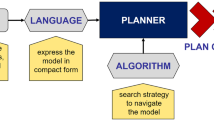Abstract
In complex systems, multiple aspects interact and influence each other. A vast number of entities are present in the system. Traditional modeling and simulation techniques fail to capture interactions between loosely coupled aspects of a complex distributed system. The objective of this work is to formalize and to specify a part of the Agent-oriented Software Process for Engineering Complex Systems methodology (Problem and Agency Domains) for modeling the holarchy of studied system by using a formal specification approch based on two formalisms: Petri Net and Object-Z language. Such a specification style facilitates the modeling of complex systems with both structural and behavioural aspects. Our generic approach is illustrated by applying it to FIRA Robot Soccer and is validated with the Symbolic Analysis Laboratory framework.
















Similar content being viewed by others
References
Azaiez S (1992). Approche dirigée par les modeles pour le développement de systèmes multi-agent. PhD Thesis, Université de Savoie, France.
Cossentino M et al (2007). A holonic metamodel for agent-oriented analysis and design. 3rd International Conference on Industrial Applications of Holonic and Multi-Agent Systems in LNAI, 4659, Springer-Verlag: Berlin, Heidelberg.
Cossentino M et al (2010). ASPECS: An agent-oriented software process for engineering complex systems: How to design agent societies under a holonic perspective. Autonomous Agents Multi-Agent Systems 20: 260–304.
D'inverno M and Luck M (2003). Understanding Agent Systems Springer series on Agent Technology, 2nd edn, ISBN 3-540-40700-6, Springer Verlag: New York.
Duke R, Dong JS and Hao P (2005). Integrating Object-Z with timed automata. In: ICECCS '05 Proceedings of the 10th IEEE International Conference on Engineering of Complex Computer Systems, ISBN: 0-7695-2284-X, doi10.1109/ICECCS.2005.56, pp. 488–497.
Duke R and Rose G (2000). Formal Object Oriented Specification Using Object-Z. Cornerstones of Computing. Macmillan Press: Basingstoke, UK.
FIRA Robot Soccer-ASPECSWiki http://www.aspecs.org/FIRA_Robot_Soccer.
Garoui M (2011). Vers une approche de spécification formelle des systèmes Multi-agent Holoniques. Masters Thesis, Faculty of Science of Monastir, Tunisia.
Gaud N (2007). Holonic multi-agent systems: From the analysis to the implementation: Metamodel, Methodology and Multilevel Simulation. PhD Thesis, Université de Technologie de Belfort-Montbéliard, France.
Gaud N, Hilaire V, Galland S and Koukam A (2008). An Organizational Platform for Holonic and Multi-agent Systems, Multi-agent Systems Group, System and Transport Laboratory, University of Technology of Belfort Montbéliard. Published in the Sixth International Workshop on Programming Multi-Agent Systems (ProMAS 08) of the Seventh International Conference on Autonomous agents and Multi-agent Systems (AAMAS), Springer: Berlin, Heidelberg.
Giorgini P (1995). The Tropos Metamodel and Its Use. University of Trento, via Sommarive 14, I-38050 Trento-Povo: Italy.
Janus Project developed by the multiagent teams of the Laboratoire Systémes, Transports and the Centro de Investigación de Tecnologías Avanzadas de Tucumán, http://www.janus-project.org.
Manna Z and Pnueli A (1995). Temporal Verification of Reactive Systems—Safety. Springer Verlag: New York, ISBN 0-387-94459-1.
Mazigh B, Hilaire V and Koukam A (2011). Formal specification of Holonic Multi-agent systems: Application to distributed maintenance company. Published in the Proceedings of PAAMS 2011, Vol. 7327. Springer Verlag: Salamanca, pp. 370–378.
Mosbahi O, Jemni L, Ben Ahmed S and Jaray J (2002). A specification and validation technique based on STATEMATE and FNLOG, LNCS 2495. In: ICFEM '02 Proceedings of the 4th International Conference on Formal Engineering Methods: Formal Methods and Software Engineering. Springer-Verlag: London, UK, pp. 216–220.
Murata T (1989). Petri nets: Properties, analysis and applications. Proceedings of IEEE 77 (4): 480–541.
Natarajan S (2000a).Symbolic Analysis of Transition Systems, In: Yuri G, Phillip WK, Martin O and Lothar T (eds). Lecture Notes in Computer Science, Springer-Verlag: Switzerland, pp. 287–308.
Natarajan S (2000b). Combining theorem proving and model checking through symbolic analysis. Computer Science Laboratory SRI International, Invited Paper at CONCUR. Lecture Notes in Computer Science, Springer-Verlag: PA, pp. 1–16.
Object Management Group (2003). MDA guide. v1.0.1, OMG/2003-06-01.
Smith G (1995). A fully abstract semantics of classes for Object-Z. Formal Aspects of Computing 7 (3): 289–313.
Vinh Duc T (2005). Reseau de Petri Rapport final de TIPE, Institut de la Francophonie pour l’Informatique.
Xudong H (2001). PZ nets—a formal method integrating Petri nets with Z. Information and Software Technology 43 (1): 1–18.
Author information
Authors and Affiliations
Rights and permissions
About this article
Cite this article
Mazigh, B., Garoui, M. & Koukam, A. Use of formal languages to consolidate a Holonic MAS methodology: a specification approach for analysing Problem and Agency domains. J Simulation 7, 159–169 (2013). https://doi.org/10.1057/jos.2012.24
Received:
Accepted:
Published:
Issue Date:
DOI: https://doi.org/10.1057/jos.2012.24




